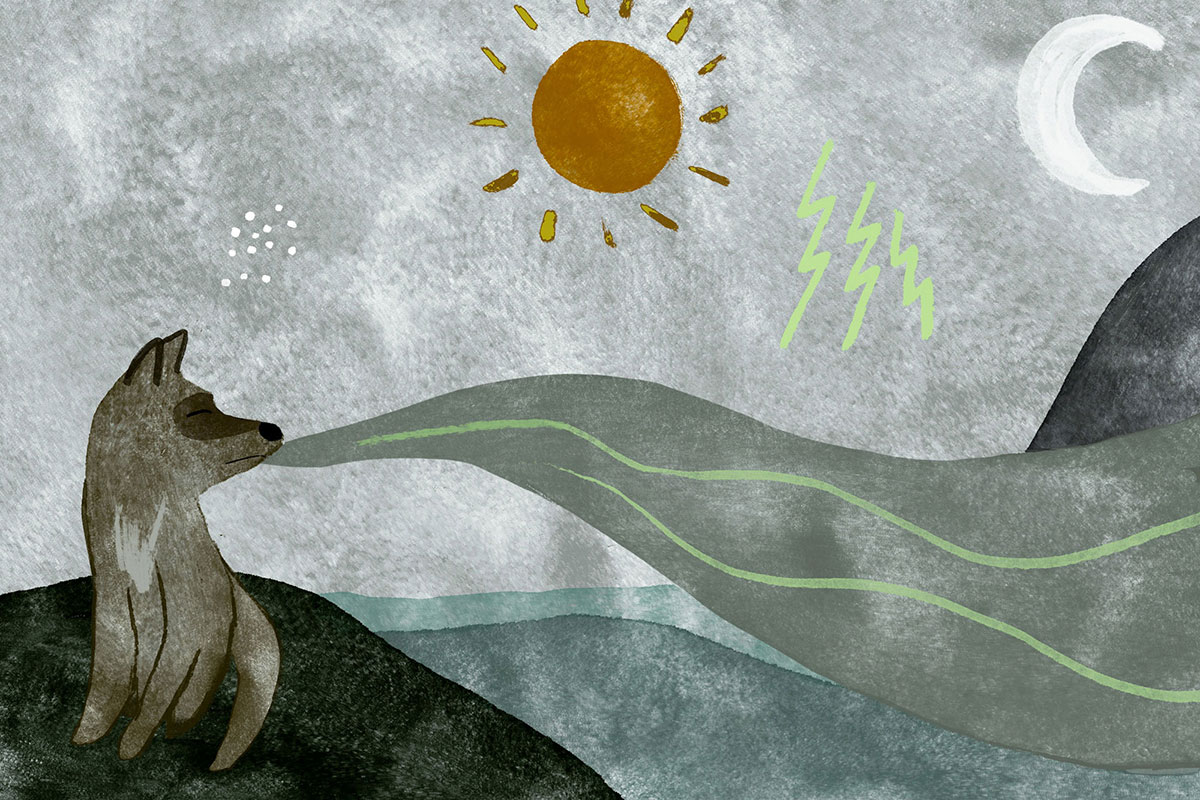The Center for Folklife and Cultural Heritage’s Language Vitality Initiative is pleased to release a free downloadable guide to better equip language revitalization practitioners with self-reflection skills. The guidebook was created with the Multicultural Initiative for Community Advancement (MICA)’s Next Steps project that trains in leadership and capacity building for language revitalization.
The guide, a forty-page downloadable PDF titled The Wolf Who Walks in Two Worlds, contains self-reflection activities woven into a narrative to be used by individuals or groups adapting to many language contexts. It guides users of all ages through activities to sustain wellness, balance, and clarity in challenging contexts in language revitalization.
“Contradictory emotions and experiences happen simultaneously within language work,” said Jacob Manatowa-Bailey (Sauk), who has spent the past five years mentoring teams across North America to develop stronger language projects through MICA’s Next Steps Language Revitalization Project. “Practitioners may experience both the joy of learning and the pain of multigenerational oppression in the same context. Reflective practice is essential to being able to see ourselves with greater honesty and to understanding the multifaceted forces that influence language revitalization.”
This guidebook builds on MICA and Manatowa-Bailey’s work, along with the previous self-reflection guidebook from Advocates for Indigenous California Language Survival. The book is the outcome of a two-year collaboration between Brittany McBeath (Kanyen’kehá:ka), Jacob Manatowa-Bailey (Sauk), Leslie Harper (Leech Lake Band of Ojibwe), Hali Dardar (Houma), and Mary Linn. Cecelia Halle translated the team’s ideas into a journal-like layout, and Sara General (Kanyen’kehá:ka) illustrated the language journey.
McBeath, a PhD candidate in Indigenous health promotion at Queen’s University, Ontario, shaped the book as she considered her own language learning journey. She synthesized the team’s conversations and researched existing literature into an annotated bibliography, then framed the guide on the concept of Ohén:ton Karihwatehkwen, or “the words that come before all else,” a Kanyen’kehá:ka ceremonial speech used to situate the self in relation to all of creation.
“Through sending greetings and thanks to all of the gifts that Mother Earth provides us, we remind ourselves of our dependence on the land for our health and prosperity,” McBeath said. “The Wolf Who Walks in Two Worlds embraces the reader’s relationship to the land and its ability to provide us with all we need to move forward through the trials and tribulations of life.”
McBeath and Dardar workshopped the guidebook at the Stabilizing Indigenous Languages Symposium in 2021, and the team incorporated their feedback. The guidebook is available for free download at the Language Vitality Initiative website.
About the Language Vitality Initiative
With Indigenous and minoritized languages under threat, the Smithsonian Center for Folklife and Cultural Heritage's Language Vitality Initiative supports community-driven language reclamation efforts. Our research promotes language use in new and traditional contexts and strengthens engagement in cultural heritage wellness. We work with digital and emerging media to promote unique voices and worldviews. We seek to educate new generations of community language practitioners and linguists through informal and formal workshops and institutes and educate majority-language users about the benefits of living in a multilingual world.
About the Multicultural Initiative for Community Advancement
The MICA Group partners with Tribal Nations and Indigenous communities to reach goals they set for themselves. With tribal sovereignty and self-determination always at the center of their work, MICA draws on a deep pool of world-class experts, both Indigenous and others, to bring new frameworks and resources to Indian Country, including partnerships, funding opportunities, ideas, and hands-on technical assistance. Most of all, MICA brings an unfailing belief in the resilience of Indigenous peoples and respect for their wisdom to know best how to nurture their communities. MICA’s Next Steps Pilot Project provides planning and development assistance to Indigenous language programs through leadership training.


